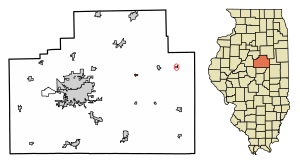Cooksville, Illinois facts for kids
Quick facts for kids
Cooksville, Illinois
|
|
|---|---|

Location in McLean County, Illinois
|
|
| Country | United States |
| State | Illinois |
| County | McLean |
| Township | Blue Mound |
| Area | |
| • Total | 0.22 sq mi (0.56 km2) |
| • Land | 0.22 sq mi (0.56 km2) |
| • Water | 0.00 sq mi (0.00 km2) |
| Elevation | 768 ft (234 m) |
| Population
(2020)
|
|
| • Total | 157 |
| • Density | 723.50/sq mi (279.70/km2) |
| Time zone | UTC-6 (CST) |
| • Summer (DST) | UTC-5 (CDT) |
| ZIP code |
61730
|
| Area code(s) | 309 |
| FIPS code | 17-16210 |
| GNIS ID | 2398622 |
| Wikimedia Commons | Cooksville, Illinois |
Cooksville is a small village in McLean County, Illinois, United States. It is home to 157 people, according to the 2020 census. This village is part of the larger Bloomington–Normal area.
Contents
Exploring Cooksville's Location
Cooksville is located in the eastern part of McLean County. It is about 18 miles (29 km) east-northeast of Bloomington. Bloomington is the main city and county seat. Illinois Route 165 passes near the village. This road connects Cooksville to Bloomington and Sibley.
Land and Water Around Cooksville
The village covers a total area of about 0.22 square miles (0.56 square kilometers). All of this area is land. Cooksville is in the area where water flows into the Mackinaw River. The Mackinaw River flows west and is a branch of the Illinois River.
Cooksville's Past: A Look at its History
How Cooksville Began
Cooksville was first planned on December 4, 1882. It was originally called "Kochsville." The founder was Frederick Wilhelm Koch (1829–1900). He was a real estate dealer from Bloomington. Within a year, the name was changed to Cooksville.
Koch was born in Westphalia, which is now part of Germany. He came to the United States in 1854. By 1860, he was living in Bloomington. He even had another neighborhood in Bloomington named Kochsville after him.
Cooksville was founded when a new railroad line was completed. This line connected Colfax to Bloomington. The railroad was later taken over by the Illinois Central company. It was sometimes called the Bloomer Line. Over time, parts of the railroad tracks were removed. This meant that grain and other goods had to be moved by road.
Village Design and Early Growth
Cooksville officially became an incorporated village in December 1901. Its population reached its highest point in 1910, with 332 residents. The original village was shaped like a rectangle. It was mostly north of the railroad tracks.
The first grain elevator in Cooksville was built in 1883 by William G. Darnell. Grain elevators are tall buildings used to store grain. Also in 1883, Harvey W. Crumbacker moved to the town. He opened a hardware store. In 1902, he built a two-story brick building in the village.
Cooksville's Population Over Time
| Historical population | |||
|---|---|---|---|
| Census | Pop. | %± | |
| 1910 | 332 | — | |
| 1920 | 297 | −10.5% | |
| 1930 | 324 | 9.1% | |
| 1940 | 269 | −17.0% | |
| 1950 | 256 | −4.8% | |
| 1960 | 221 | −13.7% | |
| 1970 | 241 | 9.0% | |
| 1980 | 259 | 7.5% | |
| 1990 | 211 | −18.5% | |
| 2000 | 213 | 0.9% | |
| 2010 | 182 | −14.6% | |
| 2020 | 157 | −13.7% | |
| Decennial US Census | |||
In 2000, Cooksville had 213 people living there. There were 91 households, which are groups of people living together. Most of the people in the village were White. A small number were from other backgrounds.
The population included people of all ages. About 23.5% were under 18 years old. About 11.3% were 65 years or older. The average age in the village was 37 years old.
Learning in Cooksville
Students in Cooksville attend schools within the Ridgeview School District.
See also
 In Spanish: Cooksville para niños
In Spanish: Cooksville para niños


